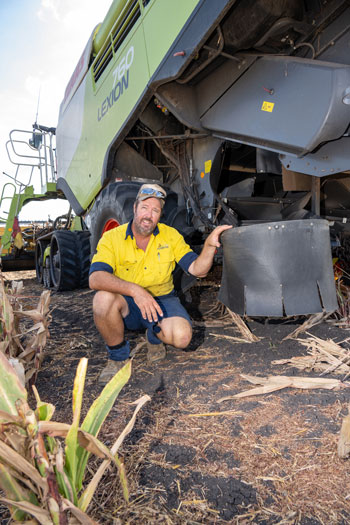Snapshot
Owners: Peter and Kylie Bach
Location: Pittsworth, Queensland
Area: 1000 hectares
Average rainfall: 660 millimetres
Soil types: Deep, self-mulching, black clay loam
Crops: sorghum, mungbeans, barley
Enterprises: grains
After a nasty frost about a decade ago, Peter Bach decided to stop planting wheat and stick with winter barley instead.
Peter and his wife Kylie farm 1000 hectares near Pittsworth, west of Toowoomba in south-eastern Queensland.
Their operation, called Kurilda Ag, operates a rotation of two sorghum crops, barley and then mungbeans in a three-year cycle.
Peter says the deciding factor in planting barley over wheat was complete crop wipeout.
While it had been a mild winter, one cold morning was enough for complete crop loss. “We made the whole lot into hay.”
At the same time, he noticed his barley crop. “It was probably at a more critical stage and there was nothing wrong with it.”
His decision was made. Since then, the malt market has expanded so he is finding more marketing options.
“We’ve been getting a few premiums for that, but I also really like barley.”
He usually plants RGT Planet and Spartacus CL , and this year will try Maximus CL .
“Maximus will allow us to hit that malt market a bit more – something we’ve been expanding on in the last couple of years. Maltsters don’t usually look up here, but in the last few years they have.”
Proactive approach to weeds takes time
Having the time to be proactive is one of the challenges when managing weeds for Peter Bach, who farms 1000 hectares near Pittsworth in south-eastern Queensland, with his wife Kylie.
Peter employs multiple tactics to keep on top of ryegrass, barnyard grass, feathertop Rhodes grass and Johnson grass but says other on-farm jobs often pull him away from weeds and the need to be on top of them constantly.
Peter’s toolbox of tactics includes a 36-metre self-propelled camera sprayer, double cropping to maximise competition, and harvest strategies such as a stripper header and chaff deck.
He has recently upgraded from a 12m camera sprayer to the wider option. It uses Biffo™, at five litres/ha, a non-residual Group 10 herbicide containing glufosinate-ammonium.
At harvesting, a Shelbourne stripper header and Emar chaff deck are used to conserve standing stubble while implementing harvest weed seed control.
 Peter uses an Emar chaff deck to conserve standing stubble while using harvest weed seed control. Photo: Nicole Baxter
Peter uses an Emar chaff deck to conserve standing stubble while using harvest weed seed control. Photo: Nicole Baxter
Both were bought about eight years ago to tackle Johnson grass on a newly acquired farm. Peter says they allow him to contain the problem. “You can see where the weeds are growing in the wheel tracks.”
Grasses enjoyed this summer’s wet weather. “We were starting to get it under control, but this year, holy dooley, the wet weather has helped Johnson grass. That said, it is contained to wheel tracks.”
With time, he would also like to re-investigate shield sprayers. “We were going down that path and then we moved away from the idea. But I think we need to get back to it again.”
With higher bars for crop clearance, shield sprayers also protect crops from spray drift, reduce compaction and protect stubble cover.
It could work well for in-crop spraying once sorghum is heading, he says. “That’s when problems really show up.”
Sown twice in a three-year rotation with barley, sorghum is Kurilda Ag’s strongest economic performer, with five tonne/ha yields on average.
Peter says while others might achieve higher yields, he would rather double-crop sorghum than fallow. “I believe the most efficient rain you will ever receive is in-crop rain. If we get a crop in and then five millimetres of rain, it actually might help. Whereas, in a bare paddock, it can’t do that much.”
Peter mainly sows Pacific seed varieties and, this year, with his new agronomist, Nick Fritz from Internode Agronomy, he had to contend with fall armyworm. Together, they decided to spray 80 per cent of the sorghum crop with Altacor®.
“We are writing the rule book as we go, and I’d rather be proactive than reactive.”
Peter says the cost was large, but sorghum is an economically important crop. “At the end of the day, what’s $30,000 when you have good sorghum? We can deliver at $350/tonne.”
When not tackling weeds or newly emerging pests, Peter and his three staff are also busy “working with steel”. So far, they have engineered a chaser bin recently and are now turning their hand to silos. “They are so expensive to buy but important for marketing options.”

























































